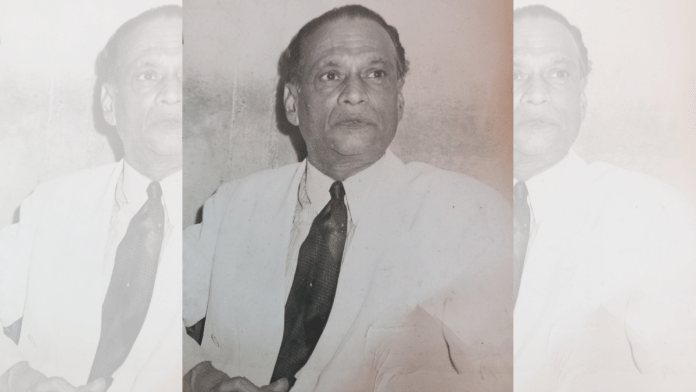Ashok Gopal throws light on ‘Barrister Samarth’ of Mumbai, one of ‘Doctor’ Ambedkar’s intimate savarna associates. The opinion is based on information given by archivist Vijay Surwade and Sulakshna Ardeshir (nee Samarth), Manohar Samarth’s second daughter.
Most historians studying the life of BR Ambedkar do not give even footnote importance to 19 May — the birth anniversary of Manohar Balkrushna Samarth, one of Babasaheb’s close friends and associates in Bombay. A renowned lawyer, he was popularly known as ‘Barrister Samarth’. The two shared a warm equation — while Ambedkar addressed him by his last name, Samarth called him “Doctor”. Theirs was an unusual friendship at that time, for Samarth belonged to a privileged family of the Chandraseniya Kayastha Prabhu (CKP) jati, an ‘upper’ caste.
Samarth’s father had been the diwan of Dewas, a princely state located in present-day Madhya Pradesh. Young Samarth was skilled at horse riding, shooting, and tennis besides being an avid reader. In the early 1920s, he came to Bombay to pursue higher studies. Earning a BA in politics and LLB from Bombay University, he went on to receive training in law at Lincoln’s Inn in London in 1927. During his time in England, he developed an interest in the trade union movement.
On his return to India, Samarth started practising at the High Court of Bombay. It was the court library where he first met Ambedkar — a love for reading sparked a deep friendship. When Samarth decided to get married in a civil ceremony, he asked Ambedkar to be the principal witness. The bride, Narmada, was a highly educated CKP woman from a family of famous actresses — including Durga Khote, and later, Nutan and Tanuja. The legacy was carried on by the couple’s eldest daughter Alaknanda, a stage actress who shot to fame with Ebrahim Alkazi’s 1960 production of August Strindberg’s Miss Julie.
Also read: Non-Dalits can go through life not knowing Ambedkar’s work, jolt needed: Author Ashok Gopal
Getting into politics
When Ambedkar formed his first political party, the Independent Labour Party in 1936, he appointed Samarth as one of the general secretaries. A decade later, when Ambedkar founded the People’s Education Society (PES), Samarth was appointed to its governing board. As lawyers, they even fought some cases together.
After achieving some financial success, Samarth was able to rent an apartment in Lotus Court, an art deco building at Churchgate, near the Cricket Club of India. The Hindi film actor-director IS Johar was among the other residents of the building. Ambedkar frequently visited his friend at Lotus Court. The two shared a love for fine clothing, food, and intelligent conversations.
But the relationship went beyond that — Samarth’s daughter Sulakshana recalls how Ambedkar once broke down at their dining table, recounting how his mother Bhimabai could never wear a clean, new sari. When she managed to get one, it had to be trampled in dust, as Mahar women could not be seen in new clothes.
Sulakshana also reminisces how hundreds of Ambedkar’s followers would gather when he visited their home. “There would be a long queue, stretching three floors down the staircase of Lotus Court and extending all the way to Eros Theatre three hundred metres away. People would enter the apartment one by one, touch his feet, and leave silently.”
Also read: What you didn’t know about Ambedkar’s Poona Pact journey: celebration to criticism
After Ambedkar’s death
After ‘Doctor’ died in 1956, Samarth assumed the role of acting head of the PES till a permanent chairperson was appointed. He could not be the chairperson, as under the PES constitution drafted by Ambedkar, the post could only be held by a Buddhist and Samarth had not converted. Samarth, though, served on the PES governing board till his death. Sulakshana recalls that her father would make frequent visits to Mahad, where the PES had established a college in Ambedkar’s honour.
As his educational work increased, Samarth’s legal practice began to decline. The family had to move out of Lotus Court to more modest accommodations downtown. His wife Nirmala (as she was called after marriage) took up work as a mathematics tutor and student counsellor. Nonetheless, the daughters continued their education at an upscale school in the southern part of the city. “It is your gateway to success,” Samarth told Sulakshana.
Samarth died on 26 August 1977 at the age of 75. In accordance with his wishes, his family donated his entire book collection, including leather-bound volumes of Oscar Wilde’s complete works, to the PES’s Siddharth College in Fort. And after his body was cremated, the ashes were brought to Chaitya Bhoomi, Dadar, where Ambedkar had been cremated, and scattered into the Arabian Sea. Even in death, Barrister Samarth desired to be close to his friend ‘Doctor’.
Ashok Gopal is the author of ‘A Part Apart: The Life and Thought of B.R. Ambedkar’, published by Navayana. Views are personal.
(Edited by Humra Laeeq)






